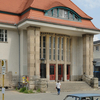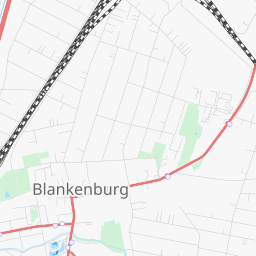Berlin-Blankenburg station
- Railway line between Berlin and Szczecin
- Connections to Berlin outer ring
- Connection to the industrial railway Tegel -Friedrichsfelde
I7i11i12i13i15i16i16i17i20
The train station Berlin- Blankenburg is operated in passenger of the Berlin S -Bahn. Here, the S-Bahn routes branch off along the railway Szczecin and Berlin outer ring. In the 1960s and 1970s he was also a transfer point to steam or diesel-powered commuter trains. The railway station with its neo-classical reception building is a listed building.
Location and Name
The station is located in the west of Berlin Blankenburg hamlet not far from the border with the district of Buchholz in Pankow district in the north of Berlin. The station is located at km 8.43 Szczecin railway in high position. The tracks cross in the station area on a bridge Bahnhofstrasse. About two kilometers north of the station is the Karower cross where the Berlin outer ring crosses the Szczecin railway. Originally called the station only Blankenburg Blankenburg later ( b Berlin).
History
The 1843 Szczecin railway had opened between Berlin and Bernau over 30 years no intermediate stations for the passenger traffic. The Blankenburg station went on June 1, 1877 as the first of these stations in operation, a few weeks later, the Gesundbrunnen whose ring -track part has already opened some years before. With the opening of more intermediate stops developed in the following years, a continuously growing suburban traffic between Berlin and Bernau above Blankenburg.
For freight transport was a freight line in 1907 by Friedrich field to Blankenburg in operation, which was renewed a year later on Luebars to Tegel. This industrial railway Tegel -Friedrich field under crossed south of the station Blankenburg Szczecin railway and was connected through a connecting track to the Blankenburg station.
Due to the rapidly growing suburban Szczecin railway between 1906 and 1911 has been expanded to four tracks, separated long-distance and suburban services and laid the tracks in the area Blankenburg on a dam. The facilities of the station were thereby completely rebuilt, and the Reception building comes from that time. The suburb route to Bernau and thus the Blankenburg station was 1924, the first track that was electrified with direct current. In Blankenburg a sweeping and parking area were built for the DC trains little later S -Bahn said.
For the avoidance of West Berlin in the early 1950s the Berlin outer ring was formed. It occurred on the Karower cross-connection curves for Szczecin railway that connected operatively to the Blankenburg station. The S -Bahn ran up to the building of the Berlin Wall in 1961 initially freely between the two parts of Berlin. After construction of the Wall, the S -Bahn trains ran from Blankenburg no longer in the direction of Berlin - fresh spring, but only over the eastern ring road. End of 1961, an S -Bahn train station branch from Blankenburg went to the outer ring for trains in the direction of Oranienburg in operation. The trains of the Heidekrautbahn from Basdorf could not go to Berlin Wilhelmsruh station as a result of building the wall. For them, a temporary platform in Blankenburg at the exit group was formed to industrial railway. He was on the other side of the tracks beyond the station road and was awkward to reach from the S- platform, which was criticized among the passengers. Since 1976, the trains from Basdorf terminate at the S platform in Karow; the platform in Blankenburg was dismantled.
In freight transport, the station had little significance, its most important function in that respect was as connecting the station to the railway industry. The section of the industrial railway of the sector boundary had been interrupted in 1952. The west of the station Blankenberg remaining connections in the area Buchholz and Niederschoenhausen were still operated until 1972. The line was then dismantled because of the construction of the highway to Pankow, which runs directly west of the station. In 1988, the industrial railway between Marzahn and Weissensee was interrupted, so that only a few connections have been serviced in the field Weissensee From Blankenburg. After the turn of the operation on the industrial railway was completely set and dismantled the equipment.
After the closure of the nearby marshalling yard Pankow 1997, the remote tracks were interrupted in the region Blankenburg for several years. Between 2003 and 2005, the bridges of the S- Bahn tracks were renewed on the Bahnhofstrasse, while the remote tracks were partially used as a substitute. In 2006, the renewed remote tracks in connection with the construction of the north- south trunk railway through Berlin and Berlin's new central station in operation.
Facilities
The original station was south of the station road which crossed the railroad tracks at ground level. From that time a Bahnwärterhaus is obtained with stable block east of the railway tracks. The two vacant buildings are national monuments.
Since the route expansion in the early 20th century, the tracks are located north of the Bahnhofstrasse in high position and the reception building. Built by Charles Cornelius and Ernst Schwartz building meets the basic features of the about the same time built by the same architect reception buildings at the Szczecin railway in Pankow, Pankow -Heiner village, Karow, Book, Röntgental and Zepernick. Like almost all of these stations is the reception building a dressed- two- story brick structure on limestone plinth and hipped roof and an open staircase with wrought iron lamps. The largest part of the building is next to the railway tracks. In particular, the main hall and the premises in which staff permanently stayed as ticketing and chief rooms, arranged in this section are from. Among the tracks is the access hall. The platform was equipped with a wooden roof with einstieligen riveted full wall supports. The ensemble of " reception building with a connecting corridor, staircase and platform " is a listed building.
The platform access is at the southwestern end of the platform; north of the platforms, the inverse system and the separation of the S- Bahn tracks towards Karow and direction outer ring connects. Southeast of the S- Bahn tracks and the platform are the tracks of the mainline; beyond the mainline tracks of the signal box.
Passenger
The station was always mainly suburban services. 1905 wrong about hourly trains between Berlin and Bernau stopping in Blankenburg, were added some additional trains between Berlin and Blankenburg. After separation of the suburban tracks from the long-distance transport capacity was further compressed. After the electrification of the railway station in 20 -minute intervals was served by trains to Bernau. With this offer, it remained (except for restrictions as a result of World War II ) by the end of the 1950s. At that time - first in 40 -minute intervals - a line set up, which began in Blankenburg and a provided with a power rail freight track between Pankow and the Beautiful Allee without West Berlin stations were operated in the eastern ring road went. After construction of the wall all suburban trains from Blankenburg used these later -developed twin-track connection. Since 1961, the S-Bahn to Oranienburg served the Blankenburg station, a third train group at 20- minute intervals started in Blankenburg in the south. Since the 1970s, the section between Blankenburg and book in 10 -minute intervals is operated. From 1961 to 1976 one to two steam, and later diesel-powered trains per hour were added toward Basdorf.
Today ( as of 2012) is the station of three lines, S 2, S 8 and S 9 approached. The S 2 runs in the daily traffic every 10 minutes, otherwise as the other two lines every 20 minutes. As a result of operating restrictions on the Berlin S-Bahn since 2009, the S reversed only 9 to Pankow (2012 ).

.jpg)







